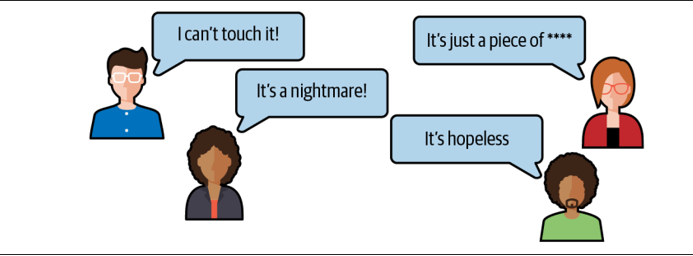How Do You Identify Unsustainable Serverless Applications?
There is no simple, single measure to easily categorize an application as sustainable or not. Growth-oriented organizations are constantly changing, adopting new tech‐ nologies, development patterns, and practices; launching new products; and reaching new markets. The pace of technical advancements in cloud and serverless computing, APIs, machine learning, and other fields disrupts the status quo of many enterprises. Keeping up requires a radical rethinking of business domains, boundaries, team structures, and application ownership.
When a team of engineers become the new custodians of an application and begin to understand its architecture and implementation, if you witness any of the emotions shown in Figure 10-5, you know it is a challenging product to sustain.

Figure 10-5. Emotions when engineers analyze or start working with an unsustainable application
Unsustainable applications are not always characterized by the use of legacy technol‐ ogies. In most cases, it is about how the technology has been used to architect and develop the applications.
The following terms are common in the industry when describing unsustainable software:
Big ball of mud (BBoM)
This is a system that lacks any coherent, understandable architecture; growth is unregulated, dependencies abound, and there is no clear separation of concerns. Many legacy monolithic applications fall into this category, due to years of negligence and a large number of accumulated fixes and hacks.
Lasagne architecture
As briefly mentioned in Chapter 3, this is an antipattern of layered architecture where there are too many layers, each depending on the one beneath it in the stack.
Spaghetti code
Spaghetti code refers to unstructured and tangled code with a high degree of hardwired dependencies, making it difficult to modify or extend the software.
Ball of serverless mud (BoSM)
The BoSM is proof that even using modern technology, you can still build unsustainable applications, as shown back in Figure 2-2 (see “Serverless is not a silver bullet” on page 39).



